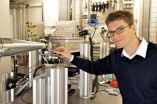(Press-News.org) A new study uncovers a protein modification that may contribute to the formation of neuron-damaging neurofibrillary tangles in the human brain. The research, published by Cell Press in the September 23 issue of the journal Neuron, may lead to new strategies for treatment of neurodegenerative diseases that result from pathological aggregation of tau protein.
Tau protein is common in the central nervous system where it helps to stabilize microtubules that form the neuronal cytoskeleton. Tau mutations have been linked with dementia and Alzheimer's disease (AD), and accumulation of phosphorylated tau protein (p-tau) has been implicated in neurodegeneration. However, the molecular mechanisms that underlie abnormal tau aggregation have not been elucidated.
"We know that an enzyme called SIRT1 is reduced in the AD brain and that this reduction correlates with the accumulation of p-tau. Further, overexpression of SIRT1 protects against neuronal loss in a mouse model of AD," explains senior study author, Dr. Li Gan from the Gladstone Institute of Neurological Disease in San Francisco, California. "However, how SIRT1 protects against tau-mediated neurodegeneration is not clear."
SIRT1 is a deacetylase, an enzyme that removes acetyl groups from proteins. Like phosphorylation, acetylation regulates many different cellular functions, including cytoskeleton dynamics. "To determine whether tau is acetylated and whether tau acetylation contributes to tau accumulation, we investigated tau acetylation in neurons, mouse models of tauopathy, and AD brains," says Dr. Gan.
Dr. Gan's group found that tau acetylation prevents degradation of p-tau, and patients at early and moderate stages of tauopathy exhibited elevated tau acetylation. The researchers went on to show that inhibiting SIRT1 increased levels of acetylated and pathogenic tau while a small molecule inhibitor of p300, an enzyme known to attach acetyl groups to proteins, promoted tau deacetylation and eliminated p-tau associated with pathological conditions.
While the link between tau acetylation and tau phosphorylation is not known, the results provide new insight into tau-mediated neuropathology. "Our findings support the model that the abnormally elevated acetylation at an early stage of the disease could block clearance of p-tau from neurons, leading to its accumulation," concludes Dr. Gan. "Our observation that p300 diminished tau acetylation and effectively eliminated p-tau supports the idea that interfering with tau acetylation may be a new approach for reducing tau-related pathology."
###
The researchers include Sang-Won Min, Gladstone Institute, University of California, San Francisco, CA, University of California, San Francisco, CA; Seo-Hyun Cho, Gladstone Institute, University of California, San Francisco, CA, University of California, San Francisco, CA; Yungui Zhou, Gladstone Institute, University of California, San Francisco, CA; Sebastian Schroeder, Gladstone Institute, University of California, San Francisco, CA, University of California, San Francisco, CA; Vahram Haroutunian, The Mount Sinai School of Medicine, New York, NY; William W. Seeley, University of California, San Francisco, CA; Eric J. Huang, University of California, San Francisco, CA; Yong Shen, Haldeman Laboratory of Molecular and Cellular Neurobiology, Sun Health Research Institute, Sun City, AZ; Eliezer Masliah, University of California at San Diego, La Jolla, CA; Chandrani Mukherjee, Johns Hopkins University, School of Medicine, Baltimore, MD; David Meyers, Johns Hopkins University, School of Medicine, Baltimore, MD; Philip A. Cole, Johns Hopkins University, School of Medicine, Baltimore, MD; Melanie Ott, Gladstone Institute, University of California, San Francisco, CA, University of California, San Francisco, CA; and Li Gan, Gladstone Institute, University of California, San Francisco, CA, University of California, San Francisco, CA.
END
Many genes code for proteins that have a "polyglutamine tract," several glutamine amino acid residues in a row. Nine inherited neurodegenerative diseases, including Huntington's disease and spinocerebellar ataxia type 1 (SCA1), are associated with mutations that cause abnormally long polyglutamine tracts. One theory suggests that accumulation of proteins with extra glutamines damages and kills neurons. However, there is evidence that glutamine tract expansion alone is not sufficient to cause disease.
Now, new research published by Cell Press in the September 23 issue ...
Two remarkable new species of horned dinosaurs have been found in Grand Staircase-Escalante National Monument, southern Utah. The giant plant-eaters were inhabitants of the "lost continent" of Laramidia, formed when a shallow sea flooded the central region of North America, isolating the eastern and western portions of the continent for millions of years during the Late Cretaceous Period. The newly discovered dinosaurs, close relatives of the famous Triceratops, were announced today in PLoS ONE, the online open-access journal produced by the Public Library of Science.
The ...
A study led by researchers at UC Davis has found how the bacteria Salmonella enterica — a common cause of food poisoning — exploits immune response in the human gut to enhance its own reproductive and transmission success. The strategy gives Salmonella a growth advantage over the beneficial bacteria that normally are present in the intestinal tract and promotes the severe diarrhea that spreads the bacteria to other people.
The findings are published in the Sept. 23 issue of the journal Nature.
"The human body normally has 10 times more microbes than human cells that ...
LA JOLLA, CA – September 20, 2010 –– A team at The Scripps Research Institute has detailed the structure of a member of the only remaining class of multidrug resistance transporters left to be described. The work has implications for combating dangerous antibiotic resistant strains of bacteria, as well as for developing hardy strains of agricultural crops.
The study was published in an advance, online issue of the journal Nature on September 22, 2010.
"Now with our crystal structure, scientists can for the first time figure out exactly how this transporter works," ...
Osteoporosis, a medical condition in which bones become brittle and fragile from a loss of density, is among the most common diseases in aging bones: In Germany around a quarter of the population aged over 50 is affected. Patients' bone material shrinks rapidly, leading to a significantly increased risk of fracture. In clinical research to date, osteoporosis is diagnosed almost exclusively by establishing an overall reduction in bone density. This approach, however, gives little information about the associated, and equally important, local structure and bone density changes. ...
Women who survive breast cancer often suffer from functional limitations that affect motion, strength and dexterity, which may adversely affect all-cause and competing-cause survival but not breast cancer survival, according to a study published online September 22 in The Journal of the National Cancer Institute.
Breast cancer survivors who have functional limitations that affect motion, strength, and dexterity are at the same risk of dying from a recurrence of breast cancer as physically fit survivors, but are more likely to die from other causes.
Breast cancer survivorship ...
SAN FRANCISCO, CA—September 23, 2010—Scientists at the Gladstone Institute of Neurological Disease (GIND) have uncovered new approaches to reduce toxic proteins in Alzheimer's disease (AD) and other neurodegenerative diseases. The results might lead to new treatments for these diseases.
"We examined a protein called tau that has been strongly implicated in Alzheimer's disease," said Li Gan, PhD, senior author on the study. "Tau forms toxic protein aggregations in the brains of Alzheimer patients."
Tau is a common protein in the central nervous system where it helps ...
FORT COLLINS – The hiatus of global warming in the Northern Hemisphere during the mid-20th century may have been due to an abrupt cooling event centered over the North Atlantic around 1970, rather than the cooling effects of tropospheric pollution, according to a new paper appearing today in Nature.
David W. J. Thompson, an atmospheric science professor at Colorado State University, is the lead author on the paper. Other authors are John M. Wallace at the University of Washington, and John J. Kennedy at the Met Office and Phil D. Jones of the University of East Anglia, ...
PORTLAND, Ore. — Researchers at Oregon Health & Science University have discovered that a form of cell division typically associated with cancer called multipolar mitosis can yield diverse, viable cells capable of protecting the liver from injury and poisonous substances, such as pesticides, carcinogens or drugs. Their findings are published online in the journal Nature.
"Our findings show that the liver, which is known to have a tremendous capacity for regeneration, also has an amazing degree of diversity. A better understanding of this process may reveal why some individuals ...
Spanish researchers have confirmed there is a genetic risk factor for osteoporosis and bone fractures. Although more studies are still needed, these findings will make it possible to take preventive measures.
Scientists from the University of Barcelona (UB) have discovered that the genetic variant 677C>T (a single nucleotide polymorphism (SNP) that is very well known in genetic studies) is linked to osteoporotic vertebral fractures, which many women suffer from after the menopause.
"In this genetic variant, the women that displayed a TT combination (or genotype) had ...



